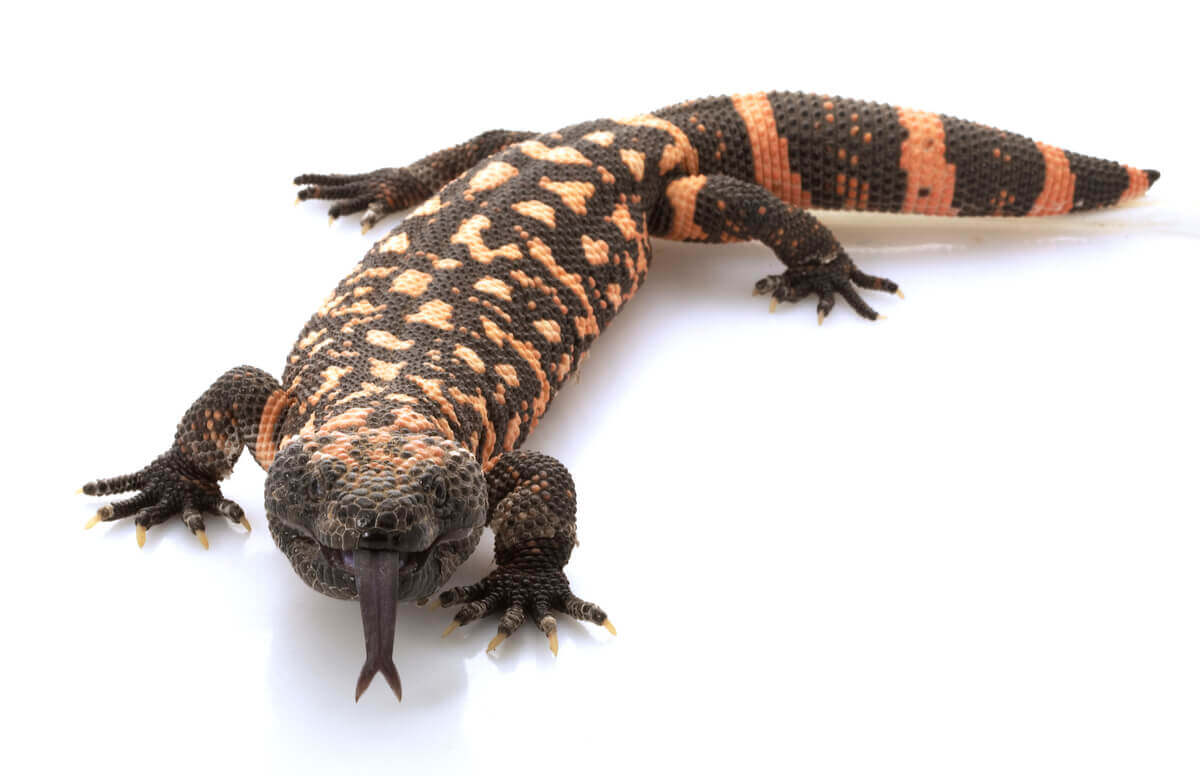Discover the Power of Poisons as Medicines


Written and verified by biochemistry Luz Eduviges Thomas-Romero
Animal poisons are effective weapons of defense or attack that allow for immobilization and/or digestion of prey. In fact, these compounds are complex mixtures of molecules with very diverse and specific functions. For thousands of years, people have used snake venom as therapeutic tools, especially in traditional Chinese medicine. In fact, their repertoire is so vast that experts have only identified and characterized less than 0.01% of these toxins. Below, we’ll take a closer look at the use of poisons as medicines.
Preventing coagulation in prey is a hidden trick in animal venom
It’s common for some of the components in the poison of various animals to contain peptides or substances with an antiplatelet aggregation effect. For this reason, they exert their effect by delaying blood clotting.
Thus, compounds such as apitoxin have been discovered in bee venom. Similarly, there are analogous elements in spiders, scorpions, sea cucumbers, caterpillars, and especially in some snakes, such as those of the genus Bothrops.
Other anticoagulant compounds are also in the salivary or exocrine secretions of some vampire bats (Desmodus rotundus and Desmodus rujus). They’re also part of the feeding strategy of hematophagous insects such as Rhodnius prolixus or intestinal parasites such as Ancylostoma ceylanicum and Ascaris.

The therapeutic application of antiplatelet therapy based on venom components
Platelet aggregation inhibitors help prevent blood clots from forming. The following drugs are based on isolated components of snake venom. They have FDA (Food and Drug Administration) approval for therapeutic application:
- Integrilin® (Eptifibatide) is a seven-amino acid peptide.
- Aggrastat® (Tirofiban) is a small molecule, non-peptide derivative of tyrosine.
Other examples of successful uses of poisons as medicines
Currently, many other components of snake venom are involved in pre-clinical or clinical trials for a variety of therapeutic applications.
The following examples show that venom can be a valuable source of new major components in drug discovery. It’s usual to cite the case of antihypertensive drugs:
- Captopril® is a drug that belongs to the group of so-called angiotensin-converting enzyme inhibitors – ACE inhibitors. Since this enzyme participates in the formation of angiotensin, the Captopril inhibitor works by producing relaxation of the blood vessels and reducing blood pressure.
Captopril has been used successfully in the US and the UK for about 40 years and has also prompted the search for more novel drugs in snake venom. Below are a few more:
- Enalapril is an angiotensin II receptor blocker – ARB – and is useful in the treatment of many heart and vascular problems. For example, in coronary artery disease, heart failure, high blood pressure, or kidney problems.
- The analgesic ziconotide – sold under the name of Prialt – is a derivative of a conical snail peptide and works on the nervous systems as a powerful analgesic.
- Exenatide, a drug for diabetes, lowers blood sugar and increases insulin production in the body. It’s based on a component in the saliva of Gila monsters, a poisonous lizard.
Poisons as medicines for the treatment of multiple sclerosis
Today, scientists are studying drugs derived from the solar anemone. This species stuns its shrimp prey by contact with long tentacles and its powerful toxins then block the prey’s nerve channels. Now, scientists have managed to synthesize safer versions than the original.
The new synthetic version of the anemone venom dramatically reverses the paralysis that accompanies multiple sclerosis in rodent models. Although it’s too early to say how useful this poison derivative will be in the long term, human trials are also currently underway,
Could snake venom treat cancer?
In the search for compounds that can be useful in the treatment of cancer, it makes sense to examine snake venom. That’s because it may contain hundreds of chemical compounds of medical interest.
Groups of scientists claim that some snake venom – applied at the proper dosage – can kill breast and colon tumors quickly. However, they admit that trials are still in their early stages. For now, they obtain results by means of in vitro tests, that is, in cell cultures of human origin.
More recently, the venom of certain spiders and its effect on the treatment of glioblastoma has been characterized, with promising results. Of course, the world of animal venom still has many surprises in store for us.

As we’ve been able to read in these lines, there are hundreds of paths open in terms of medical research regarding animal poisons as medicine. Only time will tell how many of these toxins will end up saving human lives.
Animal poisons are effective weapons of defense or attack that allow for immobilization and/or digestion of prey. In fact, these compounds are complex mixtures of molecules with very diverse and specific functions. For thousands of years, people have used snake venom as therapeutic tools, especially in traditional Chinese medicine. In fact, their repertoire is so vast that experts have only identified and characterized less than 0.01% of these toxins. Below, we’ll take a closer look at the use of poisons as medicines.
Preventing coagulation in prey is a hidden trick in animal venom
It’s common for some of the components in the poison of various animals to contain peptides or substances with an antiplatelet aggregation effect. For this reason, they exert their effect by delaying blood clotting.
Thus, compounds such as apitoxin have been discovered in bee venom. Similarly, there are analogous elements in spiders, scorpions, sea cucumbers, caterpillars, and especially in some snakes, such as those of the genus Bothrops.
Other anticoagulant compounds are also in the salivary or exocrine secretions of some vampire bats (Desmodus rotundus and Desmodus rujus). They’re also part of the feeding strategy of hematophagous insects such as Rhodnius prolixus or intestinal parasites such as Ancylostoma ceylanicum and Ascaris.

The therapeutic application of antiplatelet therapy based on venom components
Platelet aggregation inhibitors help prevent blood clots from forming. The following drugs are based on isolated components of snake venom. They have FDA (Food and Drug Administration) approval for therapeutic application:
- Integrilin® (Eptifibatide) is a seven-amino acid peptide.
- Aggrastat® (Tirofiban) is a small molecule, non-peptide derivative of tyrosine.
Other examples of successful uses of poisons as medicines
Currently, many other components of snake venom are involved in pre-clinical or clinical trials for a variety of therapeutic applications.
The following examples show that venom can be a valuable source of new major components in drug discovery. It’s usual to cite the case of antihypertensive drugs:
- Captopril® is a drug that belongs to the group of so-called angiotensin-converting enzyme inhibitors – ACE inhibitors. Since this enzyme participates in the formation of angiotensin, the Captopril inhibitor works by producing relaxation of the blood vessels and reducing blood pressure.
Captopril has been used successfully in the US and the UK for about 40 years and has also prompted the search for more novel drugs in snake venom. Below are a few more:
- Enalapril is an angiotensin II receptor blocker – ARB – and is useful in the treatment of many heart and vascular problems. For example, in coronary artery disease, heart failure, high blood pressure, or kidney problems.
- The analgesic ziconotide – sold under the name of Prialt – is a derivative of a conical snail peptide and works on the nervous systems as a powerful analgesic.
- Exenatide, a drug for diabetes, lowers blood sugar and increases insulin production in the body. It’s based on a component in the saliva of Gila monsters, a poisonous lizard.
Poisons as medicines for the treatment of multiple sclerosis
Today, scientists are studying drugs derived from the solar anemone. This species stuns its shrimp prey by contact with long tentacles and its powerful toxins then block the prey’s nerve channels. Now, scientists have managed to synthesize safer versions than the original.
The new synthetic version of the anemone venom dramatically reverses the paralysis that accompanies multiple sclerosis in rodent models. Although it’s too early to say how useful this poison derivative will be in the long term, human trials are also currently underway,
Could snake venom treat cancer?
In the search for compounds that can be useful in the treatment of cancer, it makes sense to examine snake venom. That’s because it may contain hundreds of chemical compounds of medical interest.
Groups of scientists claim that some snake venom – applied at the proper dosage – can kill breast and colon tumors quickly. However, they admit that trials are still in their early stages. For now, they obtain results by means of in vitro tests, that is, in cell cultures of human origin.
More recently, the venom of certain spiders and its effect on the treatment of glioblastoma has been characterized, with promising results. Of course, the world of animal venom still has many surprises in store for us.

As we’ve been able to read in these lines, there are hundreds of paths open in terms of medical research regarding animal poisons as medicine. Only time will tell how many of these toxins will end up saving human lives.
All cited sources were thoroughly reviewed by our team to ensure their quality, reliability, currency, and validity. The bibliography of this article was considered reliable and of academic or scientific accuracy.
- Mohamed Abd El-Aziz, T., Soares, A. G., & Stockand, J. D. (2019). Snake Venoms in Drug Discovery: Valuable Therapeutic Tools for Life Saving. Toxins, 11(10), 564.
- Vivas, D., Inga, R., & Yarlequé, A. (2012). Uso potencial de componentes del veneno de serpiente en el tratamiento del cáncer. Revista Peruana de Medicina Experimental y Salud Pública, 29, 396-401. https://www.scielosp.org/article/rpmesp/2012.v29n3/396-401/pt/
- de Souza, J. M., Goncalves, B. D., Gomez, M. V., Vieira, L. B., & Ribeiro, F. M. (2018). Animal toxins as therapeutic tools to treat neurodegenerative diseases. Frontiers in pharmacology, 9, 145.
- Bonfanti, A. P., Barreto, N., Munhoz, J., Caballero, M., Cordeiro, G., Rocha-e-Silva, T., … & Thomé, R. (2020). Spider venom administration impairs glioblastoma growth and modulates immune response in a non-clinical model. Scientific reports, 10(1), 1-16.
This text is provided for informational purposes only and does not replace consultation with a professional. If in doubt, consult your specialist.








